To family historians, including any among NYC DOCers (current & retired):
For decades prior to the March 1932 opening of the Women's House of Detention in Greenwich Village, the Correction Hospital on Welfare Island (formerly known as Blackwell's Island, currently called Roosevelt Island) served as a NYC Department of Correction (DOC) facility for female inmates.
The building originally functioned as and was called the Workhouse; that is, an institution where those convicted of lesser offenses served their sentences. But over time it also became the base for inmate medical services on the island. Although officially renamed the Correction Hospital in 1916, the Welfare Island facility's 19th century name lingered in use, even in official documents such as NYC DOC's 1930 payroll listings. While there were separate sections for male and female inmates, it became over time predominantly a female inmate facility.
Above are five images sectioned off from a "Sept. 17, 1931" group photo of the "Official Staff" of the "Correction Hospital, Welfare Island." The five section images above are so positioned as to appear a single image. The photo is possibly the island facility staffers' final picture together or, at the very least, the last before the Greenwich Village institution six months later became DOC's main facility for housing female inmates. Indeed, the photo session may have been arranged in anticipation that many, if not most of the staff would be transferred to the new "female facility" then being built in the Village.
The Sept. 17, 1931 group photo shows 79 uniformed and civilian staffers: 52 female, 27 male.
| Matrons listed at Correction Hospital, Welfare Island as of 3/16/1930 |
| first appointed | name | x | first appointed | name |
| June 9, 1896 | Mary Curtin | x | June 20, 1927 | Matilda A. V. Richards |
| Aug. 7, 1896 | Lizzie Curtin | x | Feb. 1, 1928 | Mary Willoth |
| Oct. 25, 1908 | Aida Powers | x | July 16, 1928 | Mary Reidy |
| Jan. 1, 1915 | Anna Nugent | x | Jan. 1, 1929 | Mary J. McGinn |
| June 5, 1915 | Margaret Reilly | x | Jan. 16, 1929 | Dorothy McRickard |
| July 3, 1917 | Sarah Kelly | x | Feb. 18, 1929 | Mary G. Conlin |
| Sept. 9, 1917 | Ella Timmons | x | Mar. 6, 1929 | Mary V. McKeon |
| May 7, 1923 | Rosetta M. Conway | x | Apr. 16, 1929 | Mae Martin |
| Aug. 9, 1923 | Annie M. Reilly | x | June 1, 1929 | Mary E. Canavatto |
| Sept. 12, 1923 | May T. Rousseau | x | July 16, 1929 | Mary Malloy |
| Nov. 20, 1923 | Annie E. Keller | x | Oct. 10, 1929 | Margaret Cunningham |
| May 1, 1924 | Mary Malloy | x | Oct. 10, 1929 | Minnette Beck |
| May 1, 1924 | Anna Mulligan | x | Oct. 16, 1929 | Helen Neafsy |
| Feb. 1, 1926 | Alice B. Meany | x | Oct. 10, 1929 | Ellen M. Doyle |
| Jan. 5, 1927 | Margaret Grossjean | x | Feb. 13, 1930 | Bridget O’Connor |
| Jan. 5, 1927 | Mary A. Hogan | x | Mar. 16, 1930 | Annie Harte |
A March 4, 1930 payroll listing in the archives maintained by the New York Correction History Society (NYCHS) names 32 matrons assigned to the Welfare Island facility. Most of the 32 matrons, if not all so listed would likely be among the 52 female staffers in the photo.
The table to the right, listing the 32 matrons' names and the dates they were first appointed, is provided here by NYCHS as an aid to family tree researchers. In return, NYCHS would appreciate feedback from any such researcher able to match one of the names listed with a face in the photo, or able identify one of the faces even if not among the 32 listed.
Clicking on any one of the five section images above -- left, left of center, center, right of center, or right -- accesses a corresponding close-up view of the staffers in that section. Each close-up section image page provides navigation links to move between the five close-up view pages or to return to this page.

The man who wasn't there: Click image for the story of nurse Mendel Bass who wasn't there when hospital staff photo was taken. |
|
Because NYCHS created a 2005 Women's History Month web presentation about the matrons named in the 1930 payroll listing, our site was able to begin putting together this web page, including the above table, within a matter of days after receiving the 1931 staff photo image in the latter part of February 2008. Consider it a Women's History Month 2008 project. Unveiling this presentation on March 17 also seems appropriate since all but a few of the 32 matron names above appear to be of Irish origin.
Later NYCHS will review the 1930 payroll in order to add to this page a staff table with the names of the prison keepers who were assigned to the Welfare Island Correction Hospital. Of the 27 men in the 1931 staff photo, 15 are shown in uniform.
The matron uniform was white, similar to a nurse's uniform. Only 11 of the 52 women in the photo are seen in civilian dress. The other 41 female staffers are seen in white uniforms, many with matron shields visible. How many of those without shields visible on their white uniforms were matrons and how many, if any, were actual nurses is unclear. But the nurse-like white uniform for matrons continued to be the practice at the Women's House of Detention as photos of staff at work there clearly show.
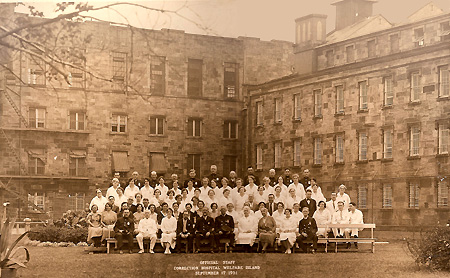
Parts of the Correction Hospital building and landscaped grounds can be seen in this reduced version of the original 1931 photo made available to NYCHS by RIHS president/NYCHS trustee Judy Berdy. |
|
The NYC Correction Hospital itself can be seen better in the image on the right. That fuller version of the original photo includes parts of the hospital building in the background as well as parts of the landscaped grounds in the foreground.
A high-resolution, full-image digital copy of the original photo was made available to the NYCHS by Judy Berdy, president of the Roosevelt Island Historical Society (RIHS) and a long-time supporter of NYCHS and a member of the NYCHS board of trustees.
Miss Berdy had purchased it via eBay. She reported that the seller, who had no information about the photo's original owner, stated he himself had gotten it from a friend, a "photo collector/dealer." Both the seller and his friend live in the central region of New York State.
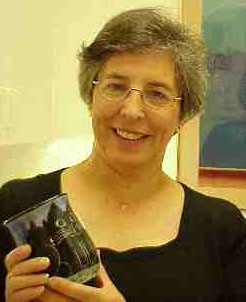
RIHS president/NYCHS trustee Judy Berdy.
Photo from Website NYC10044's Oct. 6, 2001 story on RIHS' 25 anniversary. Click image for RHIS web site. |
|
The NYCHS webmaster requested that Miss Berdy ask the seller for any information possibly shedding light on the identity of the original owner of the photo and how it came to be offered on eBay.
The seller emailed to Miss Berdy a note in response:
"My guess is [that the original owner is] someone like me who used to live in NYC and resettled up here in Central NY. . . .
"It was purchased in an auction in Syracuse NY. Apparently the person who owned it also owned a photo . . . of '15th Anniversary-Greenwich Historical Society Catherine Parker Clivette, Pres. May 25th 1937, Photo by E.J. Kelty Century 110w46284.'
"That is all my friend knew [about the Correction Hospital staff photo]. "
NYCHS research on Clivette
Some NYCHS web research following up on those tiny bits of information establish interesting
backgrounds on the two persons -- Catherine Parker Clivette and E.J. Kelty -- mentioned in connection with the 1937 historical society anniversary photo "apparently" owned by the same individual who owned the 1931 Correction Hospital staff photo.

Sketch of Merton Clivette and Catherine Parker Clivette based on image appearing on a web site operated by family members and dedicated to his memory and artistry. Click image for that web site, especially if you have Clivette-related information to share.
To view Clivette canvasses, visit
http://www.californiaviewfinearts.com
|
|
Details in their backgrounds give rise to various possible scenarios that might explain how a 1931 photo of a female inmate facility staff became "companion" to a 1937 photo of a history society's 15th anniversary celebration.
The proper name for Catherine Parker Clivette's still quite active organization turns out to be the Greenwich Village Historical Society. She founded it in 1922 and served as its president for many years. She also founded the Society for the Prevention of Unjust Convictions.
Catherine's husband was Merton Clivette, a newspaper quick sketch artist who became a vaudeville troupe manager, acrobat and magician, performing in circuses and theatres across this country and aboard. In 1906, the Clivettes settled in Greenwich Village. He studied at the Art Students League, painted full time and ran a kind of antique/curio shop he called the "Bazaar de Junk" at Number 1 Sheridan Square. His paintings appeared in solo and group exhibitions in New York and elsewhere in the U.S. even after his death in 1931. In fact, interest in his art works has continued to the present day.
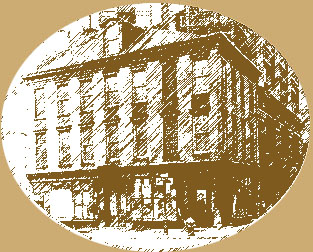
Sketch of 1 Sheridan Square based on image appearing on a web site operated by family members and dedicated to memory and artistry of Merton Clivette. Click image for that web site, especially if you have Clivette-related information to share. To view Clivette canvasses, visit http://www.californiaviewfinearts.com |
|
The Number 1 Sheridan Square address for Merton's Bazaar de Junk also figured as a meeting place for Catherine's Greenwich Village Historical Society in its infancy. A June 4, 1922 New York Times listing of events for the then upcoming week included a notice about her being scheduled to speak there at a meeting of the historical society on the subject of "Community Benefits."
Catherine continued her historical activities well into the 1940s. For example, she spoke out in 1941 against Masterbuilder Robert Moses' plan to demolish the historic New York Aquarium. However, by that time, the Bazaar de Junk had been long gone from 1 Sheridan Square
In the late 1930s, that address became a supper club called Cafe Society where neighborhood artists painted murals on its walls and where Billie Holiday, Lena Horne, Sarah Vaughn, Art Tatum and Big Joe Turner, among others, performed. Still later the place became the One Sheridan Square Theatre.
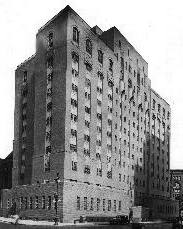
Women's House of Detention, 6th Ave. & 10th St., opened in 1932, demolished in 1974. |
|
A look at a street map of Greenwich Village makes clear how close the Clivettes' 1 Sheridan Square curio shop location was to the Women's House of Detention at 6th Ave and West 10th St. -- within easy walking distance. It was only about a half-dozen short blocks away.
Given the proximity of the women's jail to the Clivettes's shop and given Catherine's interest in the "Prevention of Unjust Convictions," chances appear to favor that the shop and/or Catherine personally acquired the 1931 Correction Hospital staff photo, by purchase or gift, from one of the staffers who had been transferred to the Greenwich Village institution from Welfare Island. Perhaps Catherine's work on behalf women "unjustly convicted" brought her into contact with the jail's staff. Friendships may have evolved with one or more of the staffers, possibly including someone in the Welfare Island group photo.
Most, if not all of the 79 persons in the group photo likely purchased copies for personal use and for distributing among family members and friends.
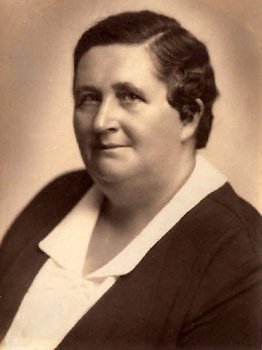
Matron Margaret Grosjean
To NYCHS:
It was so good to see on your website this group photo as my grandmother, Margaret Grosjean, was a NYC prison matron for a number of years during this period. She worked at the women's prison when it opened and used to tell the story that she was on the job the night Mae West was arrested and brought there.
Grandmother Margaret Grosjean retired as a prison matron in the late 1940s or early 1950s, I believe.
I am attaching a photo taken of her when she was a matron. She had this photo taken to give to her children, all 11 of them, as a keepsake. She had to raise them by herself after my grandfather, Henry Grosjean, was killed in a Sanitation accident in 1919.
Grandfather Grosjean worked for the City as a Sanitation Department employee. When he died, the pension to my grandmother was either $11 or $17 a month (the number is hard to make out on the document). Either way, it wasn't enough, which is why she went to work outside the home. She took the matron job even though she had to give the pension up to do so. I see on your website that the DOC matron payroll for 1930 listed her annual pay as $1,920.
My grandfather, Henry (Henri) Grosjean [b. 1863 in Germany (?), d. 1919 New York City] married Margaret Hansen in 1896. Margaret (Maggie) was born in 1865 in Denmark, arriving in New York in 1886 or 1887 and died in Dec. 1953 in New York City.  The last of their children was my mother, Wilhelmina. The last of their children was my mother, Wilhelmina.
I can't be sure if my grandmother is in the group photo you have. But she could be the woman in the center section in the middle row directly behind the lady with cap and glasses who, in turn, is behind the uniformed officer.
Once again, thank you for putting out this picture; it means a lot to people like me doing genealogy.
Caroline Hertz |
|
Such was the practice then, as it still is today, with "official" group photos. Be they pictures of a championship bowling team, a graduating class, a legislature's incoming freshman lawmakers, or a historical society's 15th anniversary celebration, the photographer makes money selling copies to those in the photographed group.
The total number of the 1931 group photo copies purchased by the individuals photographed could have, and probably did number a few hundred. So large a quantity of copies would seem to increase chances that the copy acquired by Judy Berdy off eBay once belonged to one of the staffers photographed.
Peculiarities of this particular photo
Maybe. But what if this particular photo was not one offered to photographed staff members to purchase for themselves, their families and their friends?
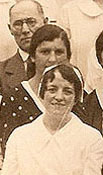 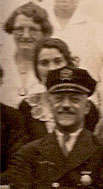
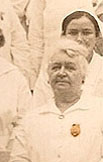
Three women whose faces were blocked in the photo. Note shield.
|
|
The question is posed because this particular photo has peculiarities that undermine its marketability among the staffers photographed. About 3/4ths of the full photo, which measures 12 inches by 20 inches, consists the building's outer walls and windows and the lawn's grass, tree limbs and shrubs. Only about 1/4th of the picture is devoted to the staff.
Additionally, the faces of three of the women in the second row are blocked by the heads of people in the first row -- one in the left-of-center section, two in the center section. Blocked faces simply won't do in the group photography business. People whose faces are blocked in group photos simply don't buy copies for themselves or anyone else.
Most likely, the photographer took several shots and kept repositioning people until no one's face was blocked. Copies of a no-blocked-faces photo would be what the photographer offered to the photographed staffers to buy. He also very likely cut the size of those copies down from 12x20 closer to a more manageable 8x12 by cropping out most of the building and landscaped lawn.
Furthermore, this particular photo lacks the kind of self-promoting "Photo By" identity mark customarily placed by the photographer on copies sold to members of a photographed group.
Under this interpretation of the 1931 photo, it is less likely a copy purchased by one of the photographed staffers and more likely a copy initially kept by the photographer himself and then later either given or sold by him to someone -- not necessarily within DOC -- who was more interested in the Welfare Island female jail building and its setting than interested in any individual staffer.
NYCHS research on Kelty
Judy Berdy, who made available to this web site a high-resolution digital copy of the full photo, said nothing visible on it, front or back, provides any clue to the photographer's identity. The only lead so far is the seller's impression that:
Apparently the person who owned it also owned a photo . . . of "15th Anniversary-Greenwich Historical Society Catherine Parker Clivette, Pres. May 25th 1937, Photo by E.J. Kelty Century 110w46284." That is all my friend knew [about the Correction Hospital staff photo]. "
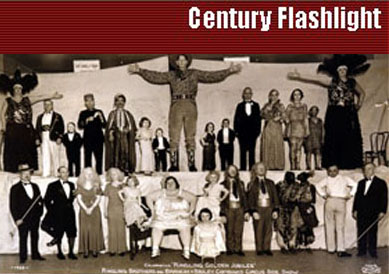
CITC Productions' www.centuryflashlight.com outlines the story of "The Mysterious Mr. Kelty" and promotes its DVD documenting "the life and work of E.J. Kelty." The circus group image above is part of the site's logo banner. Click it to access the site. |
|
Some Googling by the NYCHS webmaster turned up that the 1937 Greenwich Village Historical Society's 15th anniversary photographer's full name was Edward J. Kelty, that his photography firm's full name was "Century Flashlight Photographers" and that its correct business address was 110 West 46th Street, Manhattan.
Like Merton Clivette, Kelty's first employment had been in journalism. Whereas Clivette had worked as an illustrator, Kelty had worked as a combination reporter/photographer.
Like Clivette, Kelty was not a native New Yorker but came here to establish a business and immersed himself in another world filled with artistry and curiosities. Clivette arrived during the first decade of the 20th Century. After Navy service in WWI, Kelty moved to NYC where he set up shop, first on 44th St. near 5th and 6th Avenues and later on 46th, as a so-called "banquet photographer," taking pictures of large assemblages, the bigger the better, sometimes numbering in the hundreds. The people being photographed, the camera taking their picture, and the flash lighting had to be positioned just right so that each person could be seen in the resulting photo and therefore would want to buy one or more copies.
Like Clivette, Kelty had strong ties to the circus world. Clivette had been an acrobat and managed a traveling troupe of performers, doubling as its magician, with his wife sometimes filling the role of the young female assistant. Kelty began his circus connection by taking pictures of Coney Island sideshows featuring such odd attractions as fire eaters, sword swallowers, giants, midgets, bearded ladies and strongmen. Show owners retained Kelty to produce photos they could use for publicity handouts, ads and out-front displays. The performers themselves would buy copies too.

Duff Johnson's http://houseofdeception.com displays, among other interesting items, images of carnival and sideshow history book covers, including "Step Right This Way: The Photography of Edward J. Kelty" published by Barnes & Noble. Author Miles Barth is a curator of the International Center of Photography that held a Kelty photos exhibition with that title. The book began as its catalogue. Click the cover image to access the http://houseofdeception.com site. |
|
Soon Kelty had caught the circus bug. Each summer he'd pack equipment -- including his huge "banquet camera" capable of using 12x20 inch Nitrate-based negatives -- into his unique photo studio-on-wheels. He'd travel around the country visiting circuses, county fairs and seaside sideshows. He'd "poof" flash photos of performers individually and in groups. He'd provide copies for sale within a matter of hours by developing and printing the photos in his vehicle that also served as his sleeping quarters.
Kelty had carved out a specialty niche for his photography business but at the same time his pictures captured, with remarkable detail and artistry, the "look and feel" of another and odder universe -- that of the circuses and sideshows which once orbited our more humdrum earth. Kelty circus photos have become a historical resource preserving for us and posterity a visual record of what increasingly has become a vanishing form of entertainment, one that included but was not limited to the now politically incorrect "freak show."

For another Correction History-related presentation involving "banquet photography," click the above icon image for a virtual tour of the 1906 NYC DOC Prison Keepers' Ball. |
|
In 2002, the International Center of Photography on 6th Ave. at 43rd St., near where the old Century Flashlight Photographers was based, held a four-month exhibition entitled Step Right This Way: The Photographs of Edward J. Kelty, documenting "the diversity and strangeness of itinerant circus life during the ‘20s and ‘30s."
In that same year, while Kelty's photos were receiving renewed interest via the exhibition and the exhibition book with the same title, Merton Clivette's paintings were being exhibited in California galleries and listed for sale in various catalogues.
Given both the Clivettes and Kelty's strong circus connections, Catherine's historical society selecting Kelty to take the "banquet photo" of its 15th anniversary event could well have come about because Catherine and her husband knew of Edward's work photographing that special world to which the couple had once belonged. While they had been out of that world several years before Kelty started documenting it on Nitrate film, they likely heard about his activity from former colleagues still in it. Or, given that the Clivettes' Bazaar de Junk may have acquired some of Kelty's circus photos for resale, Catherine perhaps decided to contact him for her society's Big Picture.
That Kelty and his banquet camera would have been retained for her society's 1937 anniversary celebration without Catherine having been aware of his circus photos seems a bit of a stretch, even if possible in theory.
Since the 1931 Welfare Island women's facility staff photo appears to have been owned by the same person who owned the 1937 historical society anniversary photo, there would seem at least some chance that Kelty took the Correction Hospital staff photo.
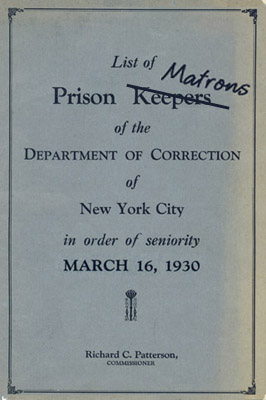
The 1930 DOC payroll booklet reflected the then secondary status of female custodial staffers. The matrons were not even included in the booklet's title. For the NYCHS 2005 Women’s History presentation, we "corrected" that oversight digitally on the booklet cover image -- a bit of historical revisionism! Click the image to access the 2-page web presentation exploring the 1930 keeper/matron payroll inequities. |
|
One can imagine his saying to Catherine Clivette after completing the Greenwich Village Historical Society anniversary assignment;
"From what I heard at your society's anniversary event, you are very interested in the Women's House of Detention in your neighborhood and in the cause of those unjustly convicted. About six years ago I photographed the staff of the women's jail then on Welfare Island. I happen to have an extra copy of it, one of the preliminary shots I took. I thought you might like to have it. Maybe some of the staffers you know at the Greenwich Village women's jail came from the Welfare Island institution and are in picture."
Of course, that little speech is entirely imaginary and is offered only as one possible scenario to explain how the two photos came to be "apparently owned" by the same person. That scenario assumes the two photos at some point were in the possession of Catherine Clivette, at least for a while.
An alternate scenario envisions a Women's House of Detention staffer, perhaps an administrator, having the 1931 Correction Hospital photo and also attending, perhaps as a member and supporter, the 1937 Greenwich Village Historical Society anniversary event where he or she was among those who were photographed and who purchased copies of that group photo.
Anyone with a better scenario to suggest and/or actual information that might shed more light on this "mystery photo" is invited to email us at the e-address below.
|
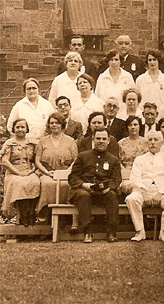
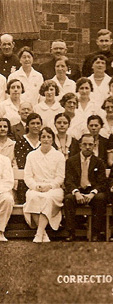
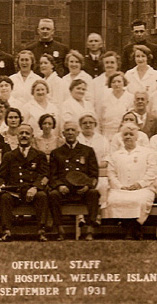

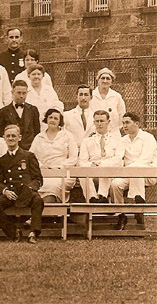







 The last of their children was my mother, Wilhelmina.
The last of their children was my mother, Wilhelmina.





